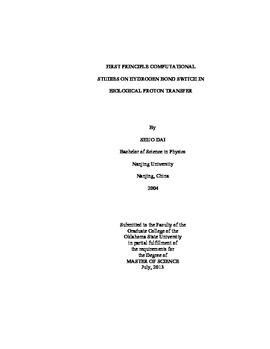| dc.contributor.advisor | Xie, Aihua | |
| dc.contributor.author | Dai, Shuo | |
| dc.date.accessioned | 2014-09-24T14:18:28Z | |
| dc.date.available | 2014-09-24T14:18:28Z | |
| dc.date.issued | 2013-07-01 | |
| dc.identifier.uri | https://hdl.handle.net/11244/11150 | |
| dc.description.abstract | Proton transfer is fundamental to biological process. However, the factor that controls biological proton transfer in proteins is not clear yet. In our lab, we have developed a proton transfer model based on Photoactive Yellow Protein. Significant progresses have been made in understanding the molecular mechanism of proton transfer. In addition to the established structural elements, proton donor and proton acceptor, previous study on our model suggests a new structural element, which we named hydrogen bond switch. In this study, first principle computation is applied to explore the geometry of hydrogen bond switch, the control element for the direction of proton transfer. Our results show that geometry of hydrogen bond between proton donor and hydrogen bond switch, namely hydrogen bond length and hydrogen bond angle, affect the switch power for proton transfer. If H2O is the hydrogen bond switch, then a net increment of 18.7kJ/mol in switch power can be acquired when switch-donor hydrogen bond length shortened from 3.00? to 2.50?. And results on hydrogen bond angle demonstrate that variations of hydrogen bond angle could only contribute a maximum of 10% in energy as much as hydrogen bond length does. We conclude that hydrogen bond with shorter length between the proton donor and hydrogen bond switch gives stronger switch power. In addition, changing the length of the hydrogen bond between proton donor and hydrogen bond switch has reversed the relative height of the two local minimums in the energy landscape. Finally, our calculations reveal that the switch power in dielectric environment could be reduced but the reducing effect that dielectric environment gave on hydrogen bond switch is less as dielectric constant becomes larger. This implies that taking dielectric environment into account, hydrogen bond switch still can provide enough switch power to proton transfer complex. | |
| dc.format | application/pdf | |
| dc.language | en_US | |
| dc.publisher | Oklahoma State University | |
| dc.rights | Copyright is held by the author who has granted the Oklahoma State University Library the non-exclusive right to share this material in its institutional repository. Contact Digital Library Services at lib-dls@okstate.edu or 405-744-9161 for the permission policy on the use, reproduction or distribution of this material. | |
| dc.title | First Principle Computational Studies on Hydrogen Bond Switch in Biological Proton Transfer | |
| dc.type | text | |
| dc.contributor.committeeMember | Mintmire, John | |
| dc.contributor.committeeMember | Zhou, Donghua | |
| osu.filename | Dai_okstate_0664M_12922.pdf | |
| osu.accesstype | Open Access | |
| dc.description.department | Physics | |
| dc.type.genre | Thesis | |
| dc.subject.keywords | hydrogen bond | |
| dc.subject.keywords | hydrogen bond switch | |
| dc.subject.keywords | molecular modeling | |
| dc.subject.keywords | physics mechanism | |
| dc.subject.keywords | proton transfer | |
| dc.subject.keywords | proton transfer in proteins | |
